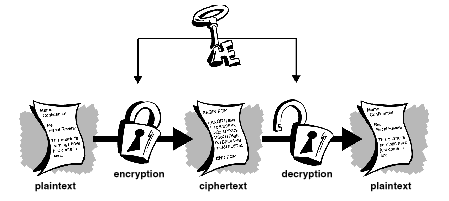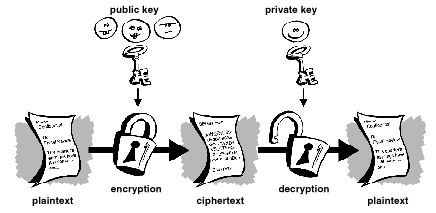|
|
|
|
Encryption and decryptionData that can be read and understood without any special measures is called plaintext or cleartext. The method of disguising plaintext in such a way as to hide its substance is called encryption. Encrypting plaintext results in unreadable gibberish called ciphertext. You use encryption to ensure that information is hidden from anyone for whom it is not intended, even those who can see the encrypted data. The process of reverting ciphertext to its original plaintext is called decryption. Figure 1-1 illustrates this process.
 Cryptography is the science of using mathematics to encrypt and decrypt data. Cryptography enables you to store sensitive information or transmit it across insecure networks (like the Internet) so that it cannot be read by anyone except the intended recipient. While cryptography is the science of securing data, cryptanalysis is the science of analyzing and breaking secure communication. Classical cryptanalysis involves an interesting combination of analytical reasoning, application of mathematical tools, pattern finding, patience, determination, and luck. Cryptanalysts are also called attackers. cryptographic algorithm, or cipher, is a mathematical function used in the encryption and decryption process. A cryptographic algorithm works in combination with a key — a word, number, or phrase — to encrypt the plaintext. The same plaintext encrypts to different ciphertext with different keys. The security of encrypted data is entirely dependent on two things: the strength of the cryptographic algorithm and the secrecy of the key. Conventional cryptographyIn conventional cryptography, also called secret-key or symmetric-key encryption, one key is used both for encryption and decryption. The Data Encryption Standard (DES) is an example of a conventional cryptosystemthat is widely employed by the Federal Government. Figure 1-2 is an illustration of the conventional encryption process.
 Caesar's CipherAn extremely simple example of conventional cryptography is a substitution cipher. A substitution cipher substitutes one piece of information for another. This is most frequently done by offsetting letters of the alphabet. Two examples are Captain Midnight's Secret Decoder Ring, which you may have owned when you were a kid, and Julius Caesar's cipher. In both cases, the algorithm is to offset the alphabet and the key is the number of characters to offset it.For example, if we encode the word "SECRET" using Caesar's key value of 3, we offset the alphabet so that the 3rd letter down (D) begins the alphabet. So starting with ABCDEFGHIJKLMNOPQRSTUVWXYZ and sliding everything up by 3, you get DEFGHIJKLMNOPQRSTUVWXYZABC where D=A, E=B, F=C, and so on. Using this scheme, the plaintext, "SECRET" encrypts as "VHFUHW." To allow someone else to read the ciphertext, you tell them that the key is 3. Obviously, this is exceedingly weak cryptography by today's standards,
it worked for Caesar, and it illustrates how conventional
cryptography works.
Key management and conventional encryptionConventional encryption has benefits. It is very fast. It is especially useful for encrypting data that is not going anywhere. However, conventional encryption alone as a means for transmitting secure data can be quite expensive simply due to the difficulty of secure key distribution.Recall a character from your favorite spy movie: the person with a locked briefcase handcuffed to his or her wrist. What is in the briefcase, anyway? It's probably not the missile launch code/ biotoxin formula/ invasion plan itself. It's the key that will decrypt the secret data. For a sender and recipient to communicate securely using conventional
encryption, they must agree upon a key and keep it secret between
themselves. If they are in different physical locations, they must trust a
courier, the Bat Phone, or some other secure communication medium to
prevent the disclosure of the secret key during transmission. Anyone who
overhears or intercepts the key in transit can later read, modify, and
forge all information encrypted or authenticated with that key. From DES
to Captain Midnight's Secret Decoder Ring, the persistent problem with
conventional encryption is key distribution: how do you get the key
to the recipient without someone intercepting it?
Public key cryptographyThe problems of key distribution are solved by public key cryptography, the concept of which was introduced by Whitfield Diffie and Martin Hellman in 1975. (There is now evidence that the British Secret Service invented it a few years before Diffie and Hellman, but kept it a military secret — and did nothing with it. [J H Ellis: The Possibility of Secure Non-Secret Digital Encryption, CESG Report, January 1970])Public key cryptography is an asymmetric scheme that uses a pair of keys for encryption: a public key, which encrypts data, and a corresponding private, or secret key for decryption. Youpublishyour public keytotheworldwhile keeping your private key secret. Anyone with a copy of your public key can then encrypt information that only you can read. Even people you have never met. It is computationally infeasible to deduce the private key from the public key. Anyone who has a public key can encrypt information but cannot decrypt it. Only the person who has the corresponding private key can decrypt the information.
 Figure 1-3. Public key encryption The primary benefit of public key cryptography is that it allows people who have no preexisting security arrangement to exchange messages securely. The need for sender and receiver to share secret keys via some secure channel is eliminated; all communications involve only public keys, and no private key is ever transmitted or shared. Some examples of public-key cryptosystems are Elgamal (named for its inventor, Taher Elgamal), RSA (named for its inventors, Ron Rivest, Adi Shamir, and Leonard Adleman), Diffie-Hellman (named, you guessed it, for its inventors), and DSA, the Digital Signature Algorithm (invented by David Kravitz). Because conventional cryptography was once the only available means for
relaying secret information, the expense of secure channels and key
distribution relegated its use only to those who could afford it, such as
governments and large banks (or small children with secret decoder rings).
Public key encryption is the technological revolution that provides strong
cryptography to the adult masses. Remember the courier with the locked
briefcase handcuffed to his wrist? Public-key encryption puts him out of
business (probably to his relief).
KeysA key is a value that works with a cryptographic algorithm to produce a specific ciphertext. Keys are basically really, really, really big numbers. Key size is measured in bits; the number representing a 1024-bit key is darn huge. In public key cryptography, the bigger the key, the more secure the ciphertext.However, public key size and conventional cryptography's secret key size are totally unrelated. A conventional 80-bit key has the equivalent strength of a 1024-bit public key. A conventional 128-bit key is equivalent to a 3000-bit public key. Again, the bigger the key, the more secure, but the algorithms used for each type of cryptography are very different and thus comparison is like that of apples to oranges. While the public and private keys are mathematically related, it's very difficult to derive the private key given only the public key; however, deriving the private key is always possible given enough time and computing power. This makes it very important to pick keys of the right size; large enough to be secure, but small enough to be applied fairly quickly. Additionally, you need to consider who might be trying to read your files, how determined they are, how much time they have, and what their resources might be. Larger keys will be cryptographically secure for a longer period of time. If what you want to encrypt needs to be hidden for many years, you might want to use a very large key. Of course, who knows how long it will take to determine your key using tomorrow's faster, more efficient computers? There was a time when a 56-bit symmetric key was considered extremely safe. Keys are stored in encrypted form. The keys are stored in two files on your hard disk; one for public keys and one for private keys. These files are called keyrings. As you use PGP, you will typically add the public keys of your recipients to your public keyring. Your private keys are stored on your private keyring. If you lose your private keyring, you will be unable to decrypt any information encrypted to keys on that ring.
|